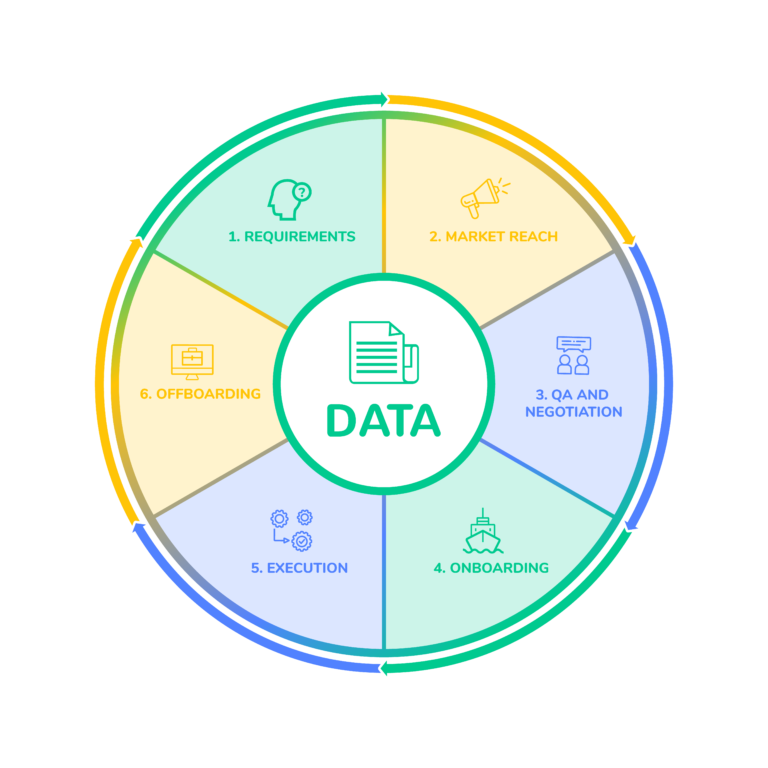Excellence in external consultant sourcing - framework
Using the external workforce, is an important ingredient in getting the right skills at the right time in your organization.
It is an organizational skill to be good at using the external workforce, and we have investigated the key phrases that you need to understand and act upon to always get the optimal consultant quality for the right price.
We have summarized our findings in the model to the right.

Do you also want to become excellent at using the external workforce?
Søren Rosenmeier would love to talk about how we can enable your organization to be excellent in sourcing external workforce.
Book a meeting with Søren directly through the calendar link below. Alternatively, you can write to him on [email protected] or give him a call directly at 0045 26130316.

Learn about the seven phases in the excellence model
Your defined requirements for the contractor is typically the document you would send to your vendors for them to bid in a matching contractor. The primary purpose is that your vendors know exactly what type of skills and personal competencies you need, but another key purpose is to make the project very attractive for the best contractors in the market.
Your requirements should as a minimum contain:
- Short description of the project (formulated as attractive as possible)
- Workplace
- % Workload
- Preferred start date
- Length of project
- Must-have competencies
- Nice-to-have competencies
- Preferred personality
- What makes the project attractive for the contractor
It is your job to define the requirements exactly based on your needs, but at the same time pay attention to giving as much flexibility and value to the contractor in order to make the project as attractive as possible for the top contractors.
Be aware that if you define many “must-have” competencies then you significantly decrease your pool of potential contractors, and this leads to a higher price. In general, it is recommendable to define as few “must-have” competencies as possible and then in the selection phase choose the best of those contractors that have bid into the project.
A final thing is to consider whether handover of knowledge and competence development of internal employees could be a part of the project scope. The contractor will focus on the formal work tasks that are defined, and by adding this to the project scope you can add a second dimension to the value the contractor is bringing to the company and the internal employees.
This is an extremely important parameter, in which most organizations have a gigantic improvement potential.
No matter how good you are in choosing the right contractor, you will always only be able to select the best one out of those you have to choose from.
The market for knowledge workers can be divided into two main groups:
- Freelance contractors
- Employees at consultant companies
The challenge for your organization is to create a setup that will let you access as large a part of the market as at all possible. Most enterprise companies work with a limited list of often 3-5 suppliers. If one or more of the companies on the list are specialized in finding and presenting freelance contractors, then the organization can have a fairly good reach in the freelance market, but you will never achieve a high coverage in the market of employed contractors using a model with just 3-5 preferred suppliers.
Digital platforms are creating a fixed process for minimizing the administration work of having many vendors. Organizations should identify their exact needs in terms of remote needs or onsite needs and then evaluate how digital platforms can help to increase market reach and bring down internal administration costs.
Many organizations allow their access to the market to be regulated by relations between employees in the organization and partners in the consultant companies. These relationships are (literally) worth gold for the consultant companies, as they in these bilateral relationships can charge a high price because the competition power of the market is not set into action.
Organizations should build trustful relationships with vendors, but in order to get the highest quality and the best prices, they must continuously use the competitive power of the market and base their market access on objective criteria.
When the requirements are sent to suppliers, the customer will receive a number of relevant offers for persons that the given vendor thinks matches the requirements.
Consultant companies will have variable degrees of quality assurance processes, but all consultant companies will have commercial pressure for selling their employed consultants or maximizing the number of freelance contractors sold.
Therefore, as a customer, you have to take ownership of the quality assurance process. It is that simple. Using the external workforce and staffing the individual projects with the optimal people each time is tightly correlated to what level of performance you get in the projects.
Specific advice on how you quality assure a given person for a given role are below:
- Analyze CVs systematically according to the following parameters:
- Specific project experience using the must-have competencies in the request
- Specific project experience using the nice-to-have competencies in the request
- Specific experience as a contractor (as opposed to internal employee experience)
- Level of relevant education
- How similar previous customers are to your organization
- What is the average length of projects
- To what degree are the previous customer returning
- Carry out personal interviews with the best-qualified contractors
- Use a carefully thought out structure for how you carry out the interview
- Include persons with substantial professional knowledge about the work that the contractor will carry out
- Discuss specifically how the contractor would start an execute the role
- Ask very specifically to the responsibility areas and results from similar projects
- Ask questions to reveal the abstraction level about the work of the contractor
- Check references from similar and recent projects.
Knowing to what extent a person will perform in a project is an art in itself. The contractor must have all the needed professional skills, but often personality is equally important.
“Negotiation” is included in this phase, because as soon as you start narrowing down your field of potential candidates, you are shifting negotiation power from you to the chosen vendors. Therefore, you must execute a negotiation phase before the interviews, and if you are using a digital platform, then this platform must support this.
Price is often the key parameter to negotiate, but you must always evaluate whether you can give away something that is easy for you to give, but of high value to the vendor. Examples could be flexibility in how and where the project is executed, or that you are willing to provide good references to the vendor if the contractor is a success.
Onboarding is the process of making it possible for the external contractor to execute his role optimally, and it is not as easy as it sounds. It is especially hard for large and complex organizations to have a consistent and efficient onboarding process. This means that time and money are wasted, and often it is the very basic things that are not in place.
A broken onboarding process is like friction that makes your organization slow and inefficient in using the power of the external workforce. It is quite simple to solve, but it requires that you define some simple processes as well as who in the organization has the responsibility for consistently executing these processes.
Before a new contractor starts on a project, you must as a minimum have the following in place:
- A contract signed by both parties
- Defined who should approve timesheets or deliveries
- Have the vendor created in the relevant systems and a lean invoicing process set up
- Email and access to all relevant systems for the contractor
- PC and workplace ready for the contractor
- Clearly defined expectations about work tasks and deliveries
As soon as the contractor starts, it is important that she feels welcome and accepted as part of the team. Even though a contractor is always hired to deliver a hard-core work effort and cannot expect such “soft” things from the customer, this is exactly why you as a customer can differentiate yourself and with a little effort create a big impression. contractors are human beings and you want all persons in all projects to be ready to go the extra mile needed to create exceptional results.
As soon as the contractor starts it must be ensured that:
- The contractor is introduced to all relevant persons
- There is a “pep talk” meeting with the contractor about goals and visions for the project
- Basic training in relevant systems and processes are conducted (ideally these are done using video-based training before start)
- The first work tasks are clearly defined and understood by the contractor
If you have been able to successfully find, quality assure and onboard a great contractor that matches the requirements, you have the right foundation for getting maximum value in the execution phase.
A key question is whether you from a management perspective should treat your external contractors differently than your permanent employees, and the answer is dependent on the nature of the contractor’s role.
For roles that are primarily execution and where the contractor becomes an integrated part of your team, you should minimize the difference. This will improve collaboration and therefore also productivity. If the contractor is an expert in his field, you have a great chance of upgrading the competencies of your permanent employees by encouraging knowledge sharing and coaching from the contractor.
For contractor roles that are more strategic and consultative in their nature, there can be a great advantage in keeping a distance, so an objective outside-in perspective is kept by the contractor throughout the project.
In the execution phase, you must ensure to measure the quality of each individual contractor, and this has to be kept simple and easy. If it is too complex and time consuming to measure quality, you risk that it is not done at all. For maximum simplicity, we recommend a simple 1-5 grading of satisfaction with the contractor by the direct manager.
Measuring quality has both an immediate and a long-term purpose.
The immediate purpose is that it provides a mechanism for revealing improvement potential. You simply should not accept bad or mediocre contractors in your organisation. If there is not high satisfaction, action must be taken to improve the situation by addressing the issues or simply by taking the consequence and replacing the contractor.
The long-term purpose is to be able to take data-driven actions on your use of the external workforce. By aggregating quality measurement on vendor level and comparing to other parameters like price or speed of delivery, you will have a much stronger insight into the true value of different vendors, and this should guide your future sourcing and vendor priorities.
To be excellent in having the right competencies available at the right time, you need to be excellent in reaching out in the market and finding the perfect person for the right price, but you also need to be excellent in making that person leave the organization again.
Offboarding an external contractor has an administrative aspect, but also a knowledge aspect, and it is essential to enable the organization to build upon the work the contractor has done.
The administrative aspect is rather simple, but often it is not done and in these cases, a burden of irrelevant data is built in systems and administration processes leading to complexity in the organization.
To handle the administrative part of the offboarding you need a link to the onboarding process and ensure that the contractor is removed from all systems and administrative processes that they were onboarded on. It must be clear in the organization who is responsible for doing this.
A challenge using the external workforce is the loss of knowledge that happens when a given contractor leaves the organization, and some completely avoid using the external workforce because of this.
To minimize the knowledge loss it is important to consider this aspect from the beginning of the period and ensure that the knowledge and experience from the contractor is anchored in the organization among permanent employees. This is partly done by ensuring that the contractor is not acting in isolation, but is an integrated part of a team, and it is partly done by ensuring that the contractor is documenting her work as an ongoing process
Even with a high degree of continuous knowledge transfer, there needs to be a formal handover process when the contractor is leaving. The organization should have a template for this that the individual department and projects can use as a starting point.
It is almost always possible to make an agreement with the contractor, that she can be contacted in case of questions related to the work of the contractor. In many situations, it also makes sense to make a flexible agreement with the contractor, e.g. a certain amount of hours, that can be used on an ad-hoc basis whenever needed.
The purpose of contractors is to have temporary expert knowledge or temporary execution power. It can be a smart decision to have an external contractor for long periods, but it then needs to be a conscious decision then.
Therefore you need to have an overview of contractors that have been part of the organization for longer than a defined period, and ensure that a conscious decision is taken whether the given contractor should stay or leave the organization.
Most enterprise organizations do not have a consolidated overview of their external contractors across all departments and projects. Often, the consolidated overview can only be made by involving managers across the organization and gathering information and spreadsheets.
If an organization does not have this data, it limits the agility and the ability to continously improve. The organizations must have an overview of their contractors in real-time, and relevant data to have is:
- contractors
- contractor Category
- Projects
- Suppliers
- Billing accounts (PO numbers)
- Hourly rates
- Invoiced costs
- Estimated future costs
- Contracts
- contract periods
- Rated satisfaction score
Ideally, you must be able to slice and dice the above parameters in exactly the way that you want, to make any combination of data points that can support a strategic decision.
Below are three examples of reports that could be relevant:
- A report showing current contractors, projects, contract periods and all other administrative data
- A report showing cost per project divided into vendors and contractors
- A report comparing vendor hourly rates and average satisfaction scores for given contractor categories
The above gives an idea about what data is necessary in order to optimize and make the right decisions based on the expected future needs.
The ongoing administration must also be reduced to a minimum, and in order to do this you must have:
- Unified contracts and overview of potential deviations
- A standardized way of ensuring compliance according to company policies for each contractor
- A standardized way of receiving correct invoices and paying correctly
- A standardized way for vendors to send timesheets and a defined approval process that is linked to the release of payment
External Workforce Platform
Onsiter supports you in the full procurement process with an easy-to-use external workforce platform that gives you maximum market reach and complete control over all your consultant requests - entirely for free.
MSP solution for external workforce
Let us handle your entire consultant sourcing. By using our MSP services we will commit to making you excellent in using the external workforce.













